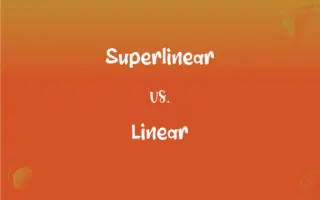Digitigrade vs. Plantigrade: What's the Difference?
Edited by Aimie Carlson || By Janet White || Updated on September 26, 2023
Digitigrade animals walk on their toes, while plantigrade animals walk on the soles of their feet, with heels touching the ground.

Key Differences
Digitigrade and Plantigrade are terms used to describe different locomotion modes in animals, focusing on how the foot makes contact with the ground. Digitigrade animals, like cats and dogs, walk on their toes or digits, with their heels and ankles elevated above the ground. This mode allows for quicker, quieter movement, often advantageous for predators. In contrast, plantigrade animals, like humans and bears, place the entire sole of the foot on the ground, with heels making contact, offering stability and strength.
In the context of anatomy and evolution, digitigrade locomotion is indicative of adaptations for speed and stealth. The elevated heels and ankles in digitigrade animals contribute to longer strides and facilitate rapid motion, beneficial for both predation and evasion. Conversely, plantigrade locomotion signifies adaptations for endurance and versatility. Plantigrade animals can bear weight efficiently, and this mode of locomotion supports diverse activities like climbing and digging, making it multifunctional and adaptive.
The physiological implications of digitigrade and plantigrade locomotion are pivotal. Digitigrade animals generally possess elongated limbs and less weight on their extremities, which aids in minimizing noise and increasing pace. On the other hand, plantigrade animals, having their entire foot including the heel on the ground, have a broader base of support, aiding in balancing and carrying body weight, making them well-suited for standing and walking for extended periods.
From an ecological standpoint, the variations between digitigrade and plantigrade animals influence their roles in ecosystems. Digitigrade animals are typically active hunters, utilizing their enhanced mobility to stalk and catch prey. In comparison, plantigrade species may employ various strategies like foraging, climbing, or brute strength to acquire resources, reflecting the adaptability of plantigrade locomotion in diverse environments.
To summarize, digitigrade locomotion, characterized by walking on toes, is synonymous with agility and speed, typically found in predatory animals. Plantigrade locomotion, where the whole sole touches the ground, is associated with stability and versatility, prevalent in animals that value endurance and adaptability.
ADVERTISEMENT
Comparison Chart
Locomotion Mode
Walks on toes or digits.
Walks on the entire sole of the foot.
Anatomical Adaptation
Adapted for speed and stealth with elevated heels and ankles.
Adapted for endurance and versatility with the whole foot making contact.
Ecological Role
Typically active hunters, utilizing speed and agility.
Employ various strategies and adapt to diverse environments.
Physiological Characteristics
Have elongated limbs and less weight on extremities.
Have a broader base of support and bear weight efficiently.
Examples
Includes cats and dogs.
Includes humans and bears.
ADVERTISEMENT
Digitigrade and Plantigrade Definitions
Digitigrade
Digitigrade refers to animals that walk on their toes or digits.
Cats are digitigrade animals, moving stealthily on their toes.
Plantigrade
Plantigrade refers to animals that walk with the entire sole of their foot touching the ground.
Humans are plantigrade, placing the whole foot on the ground while walking.
Digitigrade
In digitigrade animals, only phalanges make contact with the ground.
Birds are typically digitigrade, supporting their body weight on their toes.
Plantigrade
Plantigrade locomotion is associated with a broader base of support.
The plantigrade nature of primates aids in balancing and carrying body weight.
Digitigrade
Digitigrade locomotion is associated with elongated limbs.
The cheetah’s digitigrade locomotion enables its remarkable running speed.
Plantigrade
Plantigrade locomotion is characterized by stability and versatility.
Bears, being plantigrade, can stand and walk effectively on their soles.
Digitigrade
Digitigrade locomotion is characterized by elevated heels and ankles.
The digitigrade nature of dogs contributes to their agility and speed.
Plantigrade
In plantigrade animals, both the heel and the toes make contact with the ground.
Raccoons are plantigrade, moving with their entire sole on the ground.
Digitigrade
Digitigrade implies adaptations for speed and stealth in locomotion.
Foxes, being digitigrade, can move quietly and swiftly to catch prey.
Plantigrade
Plantigrade implies adaptations for endurance and varied activities in locomotion.
Rodents, with their plantigrade locomotion, can adapt to different environments and activities.
Digitigrade
Relating to an animal, such as a cat or dog, whose weight is borne on the toes.
Plantigrade
Walking with the entire sole of the foot on the ground, as humans, bears, raccoons, and rabbits do.
Digitigrade
(zoology) Of an animal: walking on the toes, putting the weight of the body mainly on the ball of the foot, with the back of the foot, or heel, raised.
Plantigrade
(zoology) Of an animal: walking with the entire sole of the foot on the ground.
Digitigrade
(zoology) Of feet or a manner of walking: of, resembling, or pertaining to that of a digitigrade animal.
Plantigrade
(zoology) A plantigrade animal; an animal that walks with the entire sole of the foot on the ground.
Digitigrade
Belonging to the Digitigrada of the taxonomic order Carnivora.
Plantigrade
Walking on the sole of the foot; pertaining to the plantigrades.
Digitigrade
A digitigrade animal; an animal that walks on its toes, such as a cat or a dog.
Plantigrade
A plantigrade animal, or one that walks or steps on the sole of the foot, as man, and the bears.
Digitigrade
Walking on the toes; - distinguished from plantigrade.
Plantigrade
(of mammals) walking on the whole sole of the foot
Digitigrade
An animal that walks on its toes, as the cat, lion, wolf, etc.; - distinguished from a plantigrade, which walks on the palm of the foot.
Digitigrade
(of mammals) walking on the toes with the posterior part of the foot raised
FAQs
In plantigrade animals, both the heel and the toes make contact with the ground.
Raccoons are plantigrade, moving with their entire sole on the ground.
Plantigrade implies adaptations for endurance and varied activities in locomotion.
Rodents, with their plantigrade locomotion, can adapt to different environments and activities.
Plantigrade locomotion is characterized by stability and versatility.
Bears, being plantigrade, can stand and walk effectively on their soles.
Plantigrade locomotion is associated with a broader base of support.
The plantigrade nature of primates aids in balancing and carrying body weight.
Plantigrade refers to animals that walk with the entire sole of their foot touching the ground.
Humans are plantigrade, placing the whole foot on the ground while walking.
About Author
Written by
Janet WhiteJanet White has been an esteemed writer and blogger for Difference Wiki. Holding a Master's degree in Science and Medical Journalism from the prestigious Boston University, she has consistently demonstrated her expertise and passion for her field. When she's not immersed in her work, Janet relishes her time exercising, delving into a good book, and cherishing moments with friends and family.
Edited by
Aimie CarlsonAimie Carlson, holding a master's degree in English literature, is a fervent English language enthusiast. She lends her writing talents to Difference Wiki, a prominent website that specializes in comparisons, offering readers insightful analyses that both captivate and inform.































































